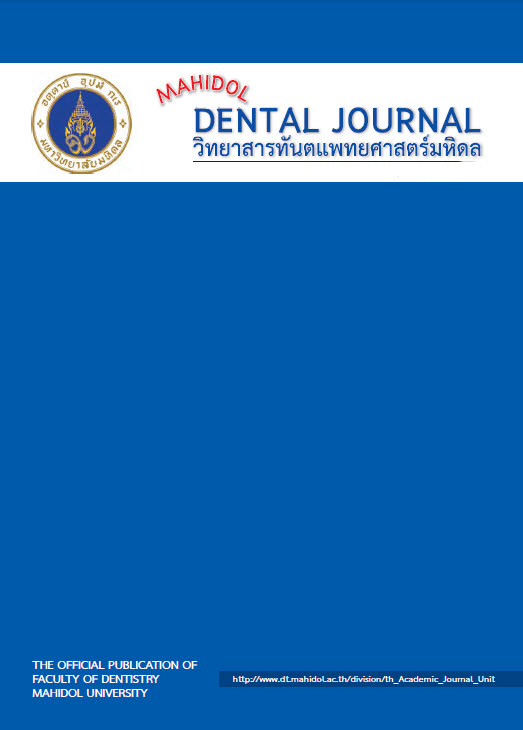Agreement on facial profile characteristics between orthodontic patients and orthodontists
Main Article Content
Abstract
Abstract
Objectives: The aim was to assess the agreement on facial profile classification and acceptance between orthodontic patients and orthodontists.
Materials and methods: A panel of experienced orthodontists (n = 6) and new orthodontic patients who were 18-40 years old (n = 251) participated in the study. All eligible participants were invited to complete a questionnaire. For the patient group, the questionnaire comprised general information, 26 silhouettes with incrementally constructed facial contour angle (FCA) with ±1SD to ±3SD and facial profile self-evaluation. The questionnaire for the orthodontists comprised the constructed incremental silhouettes and patients’ profile silhouettes. Each silhouette was asked for classification (concave, straight or convex) and acceptance (acceptable or unacceptable).
Results: Orthodontists classified -1SD silhouettes as straight profile while patients classified norm and -1SD silhouettes as straight. The orthodontists accepted profile silhouette in the range -1SD to norm while patients accepted -1SD to +1SD. Orthodontic patients’ perceptions on facial profiles were slightly different from orthodontists’ perceptions. Kappa value for agreement on facial profile classification and facial profile acceptance were 0.082 and 0.180, respectively.
Conclusions: Slight agreement on facial profile perception between orthodontic patients and orthodontists was identified. Patients had more tolerance on facial profile severity than orthodontists. Normative values of FCA of the Thai population were perceived as slightly convex profiles by orthodontists while the patients perceived them as straight profile.
Keywords: acceptable facial profile, facial profile agreement, facial profile diagnosis, facial profile perception
Article Details
References
Ackerman JL, Proffit WR, Sarver DM. The emerging soft tissue paradigm in orthodontic diagnosis and treatment planning. Clin Orthod Res. 1999; 2: 49-52.
Ricketts RM. Planning treatment on the basis of the facial pattern and an estimate of its growth. Angle Orthod. 1957; 27: 14-37.
Burstone CJ. The integumental profile. Am J Orthod Dentofacial Orthop. 1958; 44: 1-25.
Legan HL, Burstone CJ. Soft tissue cephalometric analysis for orthognathic surgery. J Oral Surg. 1980; 38: 744-51.
Holdaway RA. A soft-tissue cephalometric analysis and its use in orthodontic treatment planning. Part I. Am J Orthod. 1983; 84: 1-28.
Mejia-Maidl M, Evans CA, Viana G, Anderson NK, Giddon DB. Preferences for facial profiles between Mexican Americans and Caucasians. Angle Orthod. 2005; 75: 953-8.
Nomura M, Motegi E, Hatch JP, Gakunga PT, Rugh JD, Yamaguchi H. Esthetic preferences of European American, Hispanic American, Japanese, and African judges for soft-tissue profiles. Am J Orthod Dentofacial Orthop. 2009; 135: S87-S95.
Soh J, Chew MT, Wong HB. An Asian community's perspective on facial profile attractiveness. Community Dent Oral Epidemiol. 2007; 35: 18-24.
Imani MM, Sanei E, Niaki EA, Shahroudi AS. Esthetic preferences of orthodontists, oral surgeons, and laypersons for Persian facial profiles. Am J Orthod Dentofacial Orthop. 2018; 154: 412-20.
Nguyen DD, Turley PK. Changes in the Caucasian male facial profile as depicted in fashion magazines during the twentieth century. Am J Orthod Dentofacial Orthop. 1998; 114: 208-17.
Arnett GW, Gunson MJ. Facial planning for orthodontists and oral surgeons. Am J Orthod Dentofacial Orthop. 2004; 126: 290-5.
Luke LS, Atchison KA, White SC. Consistency of patient classification in orthodontic diagnosis and treatment planning. Angle Orthod. 1998; 68: 513-20.
Slap JW. Implications for the structural model of Freud's assumptions about perception. J Am Psychoanal Assoc. 1987; 35: 629-45.
Goodwin R, Engstrom G. Personality and the perception of health in the general population. Psychol Med. 2002; 32: 325-32.
Slovic P, Fischhoff B, Lichtenstein S. Why study risk perception? Risk Anal. 1982; 2: 83-93.
Claman L, Patton D, Rashid R. Standardized portrait photography for dental patients. Am J Orthod Dentofacial Orthop. 1990; 98: 197-205.
Lundström A, Lundström F, Lebret L, Moorrees C. Natural head position and natural head orientation: basic considerations in cephalometric analysis and research. Eur J Orthod. 1995; 17: 111-20.
Sorathesn K. Craniofacial norm for Thai in combined orthodontic surgical procedure. J Dent Assoc Thai. 1988; 38: 190-201.
Soh J, Chew MT, Wong HB. A comparative assessment of the perception of Chinese facial profile esthetics. Am J Orthod Dentofacial Orthop. 2005; 127: 692-9.
Orsini MG, Huang GJ, Kiyak HA, Ramsay DS, Bollen A-M, Anderson NK, et al. Methods to evaluate profile preferences for the anteroposterior position of the mandible. Am J Orthod Dentofacial Orthop. 2006; 130: 283-91.
Ioi H, Nakata S, Nakasima A, Counts AL. Anteroposterior lip positions of the most-favored Japanese facial profiles. Am J Orthod Dentofacial Orthop. 2005; 128: 206-11.
Polk Jr MS, Farman AG, Yancey JA, Gholston LR, Johnson BE. Soft tissue profile: a survey of African-American preference. Am J Orthod Dentofacial Orthop. 1995; 108: 90-101.
Satravaha S, Dent M, Schlegel KD. The significance of the integumentary profile. Am J Orthod Dentofacial Orthop. 1987; 92: 422-6.
Vaz TA, Santos CN, Rosário HD, Cericato GO, Oliveira GMS, Paranhos LR. Agreement between orthodontists in the diagnosis of sagittal facial patterns. Biosci J. 2015; 31.


